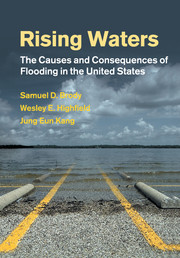12 - Conclusions
Published online by Cambridge University Press: 28 April 2011
Summary
Throughout this book, we have examined the impacts of floods in the U.S. from the national to the neighborhood scale in an effort to better elucidate the degree to which this natural hazard may impact economies, property, and daily lives. Using empirical data, we have investigated the major triggers of flooding, highlighting the importance of naturally occurring wetlands and other nonstructural strategies in reducing flood loss. Most importantly, we have identified pathways for communities to mitigate the adverse impacts of chronic and persistent floods, particularly in the most vulnerable areas. Statistical analyses of observational data over multiple time periods and spatial scales have demonstrated which mitigation strategies are most effective in reducing damages, the purpose of which is to highlight policy alternatives that enhance a community's resiliency to flooding.
However, as already noted, there exists no magic remedy for effective flood mitigation that can be applied to every affected community. Each locality has its own set of geophysical, socioeconomic, and political characteristics that must be taken into account. The fact is, as explored in Chapter 9, flood mitigation is a long-term process during which jurisdictions and organizations must constantly adjust to ever-changing conditions and new streams of information. Communities must be flexible enough to learn from their mistakes and chart new policy courses accordingly. Our hope is that decision makers can use the evidence presented in this book to establish enduring planning and policy legacies, so that over time, the adverse impacts of floods will diminish in their communities.
- Type
- Chapter
- Information
- Rising WatersThe Causes and Consequences of Flooding in the United States, pp. 181 - 182Publisher: Cambridge University PressPrint publication year: 2011



